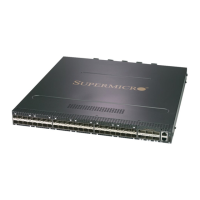Supermicro SSE-F3548S/SSE-F3548SR Configuration User’s Guide
Figure VLAN-2: Types of VLANs Supported
Once a packet is received, a switch tries to identify the VLAN for the received packet. This VLAN
identification is done according to the procedure below.
If the incoming packet has a VLAN tag and the VLAN ID in the tag is not equal to zero, then this VLAN ID is
used as the VLAN for this packet.
If the incoming packet does not have a VLAN tag (untagged packet) or if the VLAN ID in the VALN tag is
equal to zero (priority tagged packet), the packet is considered as untagged/priority tagged and the below
steps are used to identify the VLAN for this untagged/priority tagged packet.
Step 1: Use the source MAC of the incoming packet and check the MAC VLAN mapping. If the VLAN is
found for this source MAC, that VLAN ID is used as the VLAN for this packet. If the MAC VLAN is not found,
proceed to the next step.
Step 2: Use the protocol field from the incoming packet layer 2 header and check the protocol VLAN table.
If a protocol VLAN is found, that VLAN ID is used as the VLAN for this packet. If a protocol VLAN is not
found, proceed to the next step.
Step 3: This step identifies the VLAN based on a port based VLAN configuration. If the received port is in
access mode, the configured access VLAN (default is VLAN 1) is used as the VLAN for this packet. If the
received port is in trunk mode, the configured trunk native VLAN (default is VLAN 1) is used as the VLAN for
this packet. If the received port is in hybrid mode, the configured PVID (default is VLAN 1) is used as the
VLAN for this packet.
This VLAN identification procedure is shown in Figure VLAN-3: VLAN Identification Procedure.
Once the VLAN is identified for the received packet, the switch checks if the received port is a member of
this identifier VLAN. If the received is not member of the identified VLAN, the packet is dropped. If the
received port is a member of the identified VLAN, then it will be forwarded to other member ports of this
VLAN based on the forwarding logic. If there are no other member ports for this VLAN, the packet will most
likely be dropped unless it was routed or sent to the CPU or redirected by an ACL rule.
MAC Based
VLAN
Protocol
Based VLAN
Port Based
VLAN

